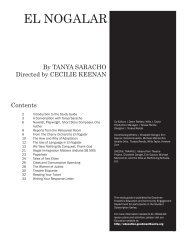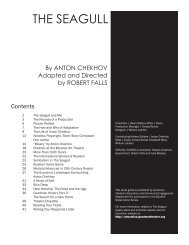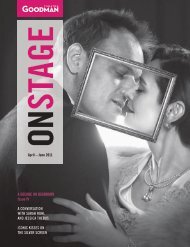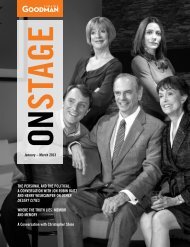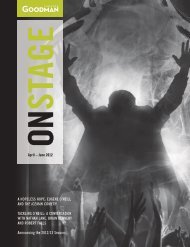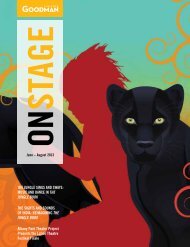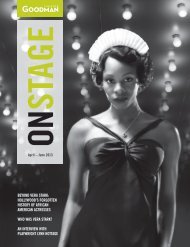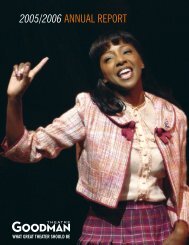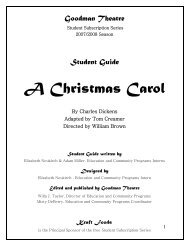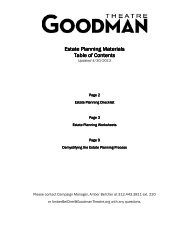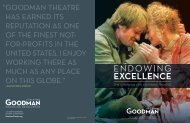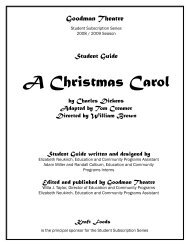A True History of the Johnstown Flood Study - Goodman Theatre
A True History of the Johnstown Flood Study - Goodman Theatre
A True History of the Johnstown Flood Study - Goodman Theatre
Create successful ePaper yourself
Turn your PDF publications into a flip-book with our unique Google optimized e-Paper software.
center stage. Audiences reveled in recognizable cultural<br />
stereotypes such as <strong>the</strong> “Jonathan” character—a rural<br />
rube with a laconic drawl and an ample amount <strong>of</strong> horse<br />
sense who never failed to get <strong>the</strong> best <strong>of</strong> his city betters;<br />
or Mose <strong>the</strong> Bowery B’hoy—an urban street tough with<br />
a heart <strong>of</strong> gold. But along with <strong>the</strong>se benign types came<br />
more distinctly oppressive forms including <strong>the</strong> Noble<br />
Savage—a subtly patronizing view <strong>of</strong> <strong>the</strong> vanquished by<br />
<strong>the</strong> victors that justified American aggression against<br />
native peoples by <strong>of</strong>fering a character that willingly<br />
sacrifices himself (and his culture) for <strong>the</strong> good <strong>of</strong> <strong>the</strong><br />
inevitability <strong>of</strong> westward expansion—or <strong>the</strong> Jumpin’ Jim<br />
Crow caricature that would dominate racial stereotypes<br />
well into <strong>the</strong> 20th century.<br />
American acting was transformed along with <strong>the</strong><br />
characters. By <strong>the</strong> 1830s, American stars, naturally<br />
attracted to “native” types and perhaps naturally more<br />
adept at performing <strong>the</strong>m as well, were now competing<br />
head to head with major British stars. Perhaps <strong>the</strong> most<br />
famous <strong>of</strong> <strong>the</strong>se homegrown stars was Edwin Forrest, a<br />
self-taught master <strong>of</strong> <strong>the</strong> popular stage who dominated<br />
American <strong>the</strong>ater for nearly three decades. His long<br />
rivalry with <strong>the</strong> classically trained English tragedian<br />
William Macready led to <strong>the</strong> infamous Astor Place Riot in<br />
1849, in which Forrest supporters stormed a Macready<br />
performance at New York’s Astor Place Opera House,<br />
resulting in <strong>the</strong> state militia killing nearly two dozen<br />
protestors. Almost none <strong>of</strong> <strong>the</strong> popular performers <strong>of</strong><br />
<strong>the</strong> time were particularly successful in England, where<br />
tastes were not inclined toward American standards.<br />
During <strong>the</strong> second half <strong>of</strong> <strong>the</strong> 19th century, <strong>the</strong> popular<br />
plays were American moralistic melodramas that<br />
reflected <strong>the</strong> values <strong>of</strong> <strong>the</strong> ever-increasing middle-class<br />
audience. Among <strong>the</strong> best-known plays <strong>of</strong> <strong>the</strong> era, Uncle<br />
Tom’s Cabin became <strong>the</strong> most produced play on <strong>the</strong><br />
American stage and remained a standard well into <strong>the</strong><br />
20th century.<br />
In <strong>the</strong> 1860s, American acting shifted to suit <strong>the</strong> new<br />
forms <strong>of</strong> dramas when performers began to study <strong>the</strong><br />
new French form <strong>of</strong> acting created by François Delsarte.<br />
The “Delsarte Method” was a studied, meticulously<br />
detailed approach to applying <strong>the</strong> new “scientific<br />
thinking” to acting. Through careful observation <strong>of</strong><br />
everyday behavior, Delsarte devised a system that<br />
attempted to teach acting through detailed re-creations<br />
<strong>of</strong> <strong>the</strong> mechanics <strong>of</strong> human movement and emotion.<br />
As taught and executed on <strong>the</strong> French stage, Delsarte’s<br />
system worked as a means to illustrate <strong>the</strong> more<br />
naturalistic/realistic dramas that were becoming <strong>the</strong><br />
rage. But <strong>the</strong> system, as brought over to New York<br />
by American students in <strong>the</strong> late 1860s, lost much<br />
in translation. The American version emphasized<br />
<strong>the</strong> superficial over substance; what began as mere<br />
guidelines for motivated movement in Paris became<br />
strict rules <strong>of</strong> exaggerated gesture and hammy intentions<br />
in New York. While some actors were adept at blending<br />
<strong>the</strong> French version with <strong>the</strong> American, most were not,<br />
and American acting suffered from its poor imitation <strong>of</strong> a<br />
non-American style.<br />
What prompted <strong>the</strong> American Delsarte method to flourish<br />
at <strong>the</strong> end <strong>of</strong> <strong>the</strong> 19th century was <strong>the</strong> steady increase in<br />
audiences. As <strong>the</strong>ater continued to expand in popularity,<br />
playhouses expanded as well. Bigger structures were<br />
needed to handle both <strong>the</strong> larger audiences and <strong>the</strong><br />
new technological innovations necessary to produce<br />
<strong>the</strong> popular spectacular melodramas. Curiously, <strong>the</strong><br />
exaggerated American version <strong>of</strong> Delsarte was well<br />
suited to <strong>the</strong> giant stages and auditoriums that emerged<br />
by <strong>the</strong> end <strong>of</strong> <strong>the</strong> century. In <strong>the</strong> biggest commercial<br />
houses on Broadway, a larger-than-life acting style<br />
worked. And more curiously still, it was an acting style<br />
that was even better suited to <strong>the</strong> latest entertainment<br />
technology <strong>of</strong> silent film. Most Hollywood stars <strong>of</strong> <strong>the</strong><br />
early 20th century could trace <strong>the</strong>ir <strong>the</strong>atrical heritage<br />
directly back to <strong>the</strong> Delsarte system.<br />
A <strong>True</strong> <strong>History</strong> <strong>of</strong> <strong>the</strong> <strong>Johnstown</strong> <strong>Flood</strong> illuminates<br />
<strong>the</strong> contrasts between our modern form <strong>of</strong> realistic<br />
acting and <strong>the</strong> traditional conventions <strong>of</strong> Delsarte.<br />
By juxtaposing <strong>the</strong> “real” with <strong>the</strong> “staged,” Gilman<br />
and Falls bridge <strong>the</strong> disparity between realism and<br />
melodrama, between what is real and what is <strong>the</strong>ater,<br />
between <strong>the</strong> melodrama <strong>of</strong> life and <strong>the</strong> melodrama <strong>of</strong><br />
<strong>the</strong> stage. And in doing so, <strong>the</strong>y manage to show that<br />
what worked for <strong>the</strong> audiences <strong>of</strong> <strong>the</strong> 19th century really<br />
isn’t so different from what works for us today.<br />
28



